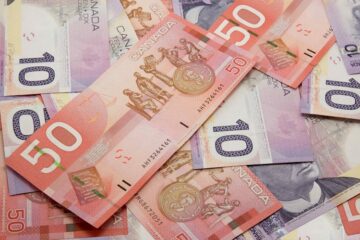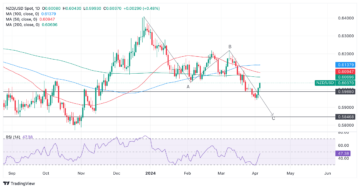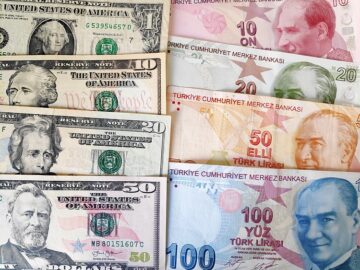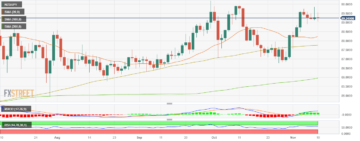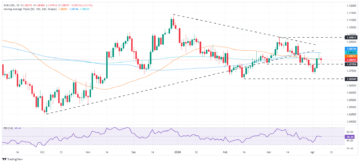
- The DXY exhibits mild daily gains in Friday’s session.
- The Federal Reserve’s measured approach alongside a robust labor market reduces expectations of rate cuts.
- The market expects no chance for a March rate cut and less than a 25% chance of a cut in May.
- Investors keenly await upcoming economic reports for further insights on economic health and implications on the Fed’s stance.
The US Dollar Index (DXY) is currently at 104.10, mildly higher thanks to stable conditions in the American economy. That stability brings down hope of earlier rate cuts by the Federal Reserve (Fed), whose officials are delaying any monetary adjustments. Next week, markets will get January’s Personal Consumption Expenditure (PCE) figures, an important data set on US inflation.
The US economy showcases durable strength as signified by resilient economic activity figures, which may signify a threat to the fight against inflation. Additionally, the robust labor market, marked by lows in jobless claims, further deters prospects for near-term interest rate cuts and, therefore, limits the Greenback’s losses.
Daily digest market movers: US Dollar remains stable as the US economy holds resilient
- The US Dollar trades mildly higher as the market gears up for next week’s Personal Consumption Expenditure (PCE) figures from January, setting a quiet tone for Friday’s session.
- Market expectations indicate a decreased likelihood of a rate cut in the near term as indicated by the CME FedWatch Too with low odds of easing in March or May. A strong US domestic economy and resilient labor market contribute to maintaining the Fed’s current stance, delaying the easing to June.
Technical analysis: DXY bulls close the week in a stable manner
The indicators on the daily chart reflect mixed sentiment with both buying and selling forces battling for dominance. On one hand, the Relative Strength Index (RSI), although flat, is stationed in positive territory, hinting toward underlying bullish strength. This bullishness is supported by the DXY’s positioning above the 20-day and 200-day Simple Moving Averages (SMAs), highlighting the resilience of buyers over a longer term.
On the contrary, the Moving Average Convergence Divergence (MACD) shows rising red bars, indicating that selling momentum is building up. Moreover, the index’s positioning below the 100-day SMA suggests that bears have not completely withdrawn from the game.
It’s worth noting that the 20 and 100-day SMAs are about to perform a bullish crossover, which would provide additional traction to the buyers and push the DXY higher.
Central banks FAQs
Central Banks have a key mandate which is making sure that there is price stability in a country or region. Economies are constantly facing inflation or deflation when prices for certain goods and services are fluctuating. Constant rising prices for the same goods means inflation, constant lowered prices for the same goods means deflation. It is the task of the central bank to keep the demand in line by tweaking its policy rate. For the biggest central banks like the US Federal Reserve (Fed), the European Central Bank (ECB) or the Bank of England (BoE), the mandate is to keep inflation close to 2%.
A central bank has one important tool at its disposal to get inflation higher or lower, and that is by tweaking its benchmark policy rate, commonly known as interest rate. On pre-communicated moments, the central bank will issue a statement with its policy rate and provide additional reasoning on why it is either remaining or changing (cutting or hiking) it. Local banks will adjust their savings and lending rates accordingly, which in turn will make it either harder or easier for people to earn on their savings or for companies to take out loans and make investments in their businesses. When the central bank hikes interest rates substantially, this is called monetary tightening. When it is cutting its benchmark rate, it is called monetary easing.
A central bank is often politically independent. Members of the central bank policy board are passing through a series of panels and hearings before being appointed to a policy board seat. Each member in that board often has a certain conviction on how the central bank should control inflation and the subsequent monetary policy. Members that want a very loose monetary policy, with low rates and cheap lending, to boost the economy substantially while being content to see inflation slightly above 2%, are called ‘doves’. Members that rather want to see higher rates to reward savings and want to keep a lit on inflation at all time are called ‘hawks’ and will not rest until inflation is at or just below 2%.
Normally, there is a chairman or president who leads each meeting, needs to create a consensus between the hawks or doves and has his or her final say when it would come down to a vote split to avoid a 50-50 tie on whether the current policy should be adjusted. The chairman will deliver speeches which often can be followed live, where the current monetary stance and outlook is being communicated. A central bank will try to push forward its monetary policy without triggering violent swings in rates, equities, or its currency. All members of the central bank will channel their stance toward the markets in advance of a policy meeting event. A few days before a policy meeting takes place until the new policy has been communicated, members are forbidden to talk publicly. This is called the blackout period.
- SEO Powered Content & PR Distribution. Get Amplified Today.
- PlatoData.Network Vertical Generative Ai. Empower Yourself. Access Here.
- PlatoAiStream. Web3 Intelligence. Knowledge Amplified. Access Here.
- PlatoESG. Carbon, CleanTech, Energy, Environment, Solar, Waste Management. Access Here.
- PlatoHealth. Biotech and Clinical Trials Intelligence. Access Here.
- Source: https://www.fxstreet.com/news/us-dollar-sees-a-slight-uptick-as-anticipation-rises-for-pce-data-202402231639
- :has
- :is
- :not
- :where
- $UP
- 10
- 2%
- 20
- 33
- 36
- a
- About
- above
- accordingly
- activity
- Additional
- Additionally
- adjust
- Adjusted
- adjustments
- advance
- against
- All
- alongside
- Although
- American
- American economy
- an
- analysis
- and
- Animate
- any
- appointed
- approach
- ARE
- AS
- At
- average
- avoid
- await
- Bank
- Bank of England
- Bank of England (BOE)
- Banks
- bars
- battling
- BE
- Bears
- been
- before
- being
- below
- Benchmark
- Benchmark Rate
- between
- Biggest
- board
- BoE
- boost
- both
- Brings
- Building
- Bullish
- Bulls
- businesses
- buyers
- Buying
- by
- called
- CAN
- central
- Central Bank
- Central Banks
- certain
- chairman
- Chance
- changing
- Channel
- Chart
- cheap
- claims
- Close
- Closes
- CME
- come
- commonly
- communicated
- Companies
- completely
- conditions
- Consensus
- constant
- constantly
- consumption
- content
- contrary
- contribute
- control
- control inflation
- Convergence
- conviction
- country
- create
- Currency
- Current
- Currently
- Cut
- cuts
- cutting
- daily
- data
- data set
- Days
- decreased
- deflation
- deliver
- Demand
- Digest
- disposal
- Divergence
- Dollar
- Domestic
- Dominance
- down
- Dxy
- each
- Earlier
- earn
- easier
- easing
- ECB
- Economic
- economies
- economy
- either
- ends
- England
- Equities
- European
- European Central Bank
- Event
- exhibits
- expanded
- expectations
- expects
- facing
- FAQ
- Fed
- Federal
- federal reserve
- few
- fight
- Figures
- final
- flat
- followed
- For
- Forces
- Forward
- Friday
- from
- further
- Gains
- game
- gears
- gears up
- get
- goods
- hand
- harder
- Have
- Health
- her
- higher
- highlighting
- Hikes
- hiking
- his
- holds
- hope
- How
- HTTPS
- implications
- important
- in
- independent
- index
- indicate
- indicated
- indicating
- Indicators
- inflation
- insights
- interest
- INTEREST RATE
- Interest Rates
- Investments
- issue
- IT
- ITS
- January
- jobless claims
- jpg
- june
- just
- Keep
- Key
- known
- labor
- labor market
- Leads
- lending
- less
- like
- likelihood
- limits
- Line
- live
- Loans
- local
- LOCAL BANKS
- longer
- losses
- Low
- low rates
- lower
- lowered
- Lows
- MACD
- maintaining
- make
- Making
- mandate
- March
- marked
- Market
- Markets
- May..
- means
- measured
- meeting
- member
- Members
- mild
- mixed
- module
- Moments
- Momentum
- Monetary
- Monetary Policy
- monetary tightening
- Moreover
- Movers
- moving
- moving average
- moving averages
- Near
- needs
- New
- new policy
- next
- next week
- no
- noting
- Odds
- of
- officials
- often
- on
- ONE
- or
- out
- Outlook
- over
- panels
- Passing
- pce
- People
- perform
- period
- personal
- Place
- plato
- Plato Data Intelligence
- PlatoData
- policy
- politically
- positioning
- positive
- president
- price
- Prices
- prospects
- provide
- publicly
- Push
- quiet
- Rate
- Rates
- rather
- reasoning
- Red
- reduces
- reflect
- region
- relative
- relative strength index
- Relative Strength Index (RSI)
- remaining
- remains
- Reports
- Reserve
- resilience
- resilient
- REST
- Reward
- rising
- robust
- rsi
- s
- same
- Savings
- say
- see
- Selling
- sentiment
- Series
- Services
- session
- set
- setting
- should
- showcases
- Shows
- signify
- Simple
- slightly
- SMA
- SMAs
- speeches
- split
- Stability
- stable
- stance
- starts
- Statement
- strength
- strong
- subsequent
- substantially
- Suggests
- Supported
- sure
- Swings
- Take
- takes
- Talk
- Task
- term
- territory
- than
- thanks
- that
- The
- the Fed
- The US Federal Reserve
- their
- There.
- therefore
- this
- threat
- Through
- TIE
- tightening
- time
- to
- TONE
- too
- tool
- toward
- traction
- trades
- triggering
- try
- TURN
- tweaking
- underlying
- until
- upcoming
- us
- US Dollar
- US economy
- US Federal
- us federal reserve
- us inflation
- very
- Vote
- want
- week
- when
- whether
- which
- while
- WHO
- whose
- why
- will
- with
- withdrawn
- without
- worth
- would
- zephyrnet

